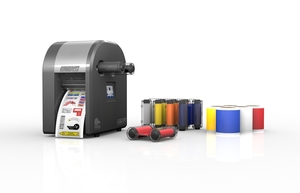

|
Edward Lowton
Editor |


|
| Home> | Handling and Storing | >Labelling, marking and barcoding | >The evolution of technical labelling |
| Home> | Efficient Maintenance | >Maintenance products | >The evolution of technical labelling |
The evolution of technical labelling
09 November 2022
In-house sign and label printers, designed for desktop operation, are becoming increasingly common in plants and factories, allowing businesses to reduce both costs and wastage, explains Clinton Church

INDUSTRIAL PLANT AND EQUIPMENT: How has technical labelling evolved over time?
Clinton Church: When used in a technical environment, labels typically fulfil three key functions: safety, ensuring correct operation and identification.
Where we've seen a change has been in the methods used to deliver these labels, with an increasing number of businesses now opting to produce them 'in-house' or 'on-site'.
There are several reasons for this. Pre-printed labels do not allow for changes and, at the same time, require higher volume purchases in order to keep costs to a minimum. Thus, if you subsequently have to change the content on the label or if you overestimate the number of labels needed, you end up with wastage.
Additionally, the need for just-in-time labelling aligns with broader trends in inventory management within the industrial sector. Bringing technical labelling in-house offers businesses additional flexibility.
IPE: With in-house sign and label printers becoming increasingly common in plants and factories, what are some of the key factors end-users should consider when investing in this equipment?
CC: I would suggest that their primary considerations should be reliability, ease of use, and versatility. From this perspective, it is important to identify the solution which offers the best return on investment – ideally a single product which satisfies a multitude of technical labelling applications.
The ideal solution will allow a business to make what they want, when they want, eliminating the need to maintain stocks of pre-prints, and helping ensure almost zero errors and waste.
One such solution is our SMS R1. It utilises a single supply roll but thanks to its in-built cutter it’s capable of cutting to all the shapes and sizes needed. This means businesses no longer have to maintain stocks of multiple rolls of different-sized materials.
Additionally, when the R1 is not printing, it will not consume the ribbon. This represents up to a 50% saving compared to traditional thermal transfer systems.
IPE: Technical labelling also plays an important role in the maintenance process. What are some of the major applications you commonly see?
CC: We see a wide range of maintenance applications for technical labels, covering everything from shutdown/turnaround labelling, flange labelling, pipe and valve identification, and calibration and inspection labels, through to lock/out-tag/out, equipment labelling, cable and wire identification, cabinet marking and unique labels informing of task-specific status.
Poor labelling in an industrial environment can have serious consequences. Equipment could be damaged if used incorrectly and maintenance takes longer if the engineer doesn’t know ‘what is where; and what condition it was last left in, while people could be seriously injured if potential hazards are not clearly identified.
Reflecting this, it goes without saying, that in a maintenance context, durability is a major requirement – the label needs to stay stuck and survive abrasion, temperatures and chemicals.
IPE: Looking ahead, which technological innovations in technical labelling are likely to define the shape of things to come?
CC: Technological developments have shifted label creation from the outside supplier and put it in the hands of the business operator. They now have the flexibility to create important messages where they want, when they want, in the quantity they want and with zero errors.
Increasing IT literacy means designing a label is no longer a mystery – although some businesses still choose to use an experienced designer to handle their labelling – in the main, it's no more complicated than using a well-known productivity suite such as Microsoft Office.
Clinton Church is sales and marketing manager, export at Rebo Systems
For more information:
Tel: +31 (0)35 6016941
- The NEW Rebo SMS R1 – colour and cut desktop sign and labelling system.
- The NEW Rebo SMS R1 – Desktop technical label production.
- Colour and cut desktop sign and labelling system.
- Desktop system for sign and labels
- Latest sign and labelling machines
- Sign & labelling systems
- Desktop sign and labelling system
- Sign & labelling system
- Signs and labels in multiple colours in one pass
- Colour and cut desktop sign and labelling system.



















